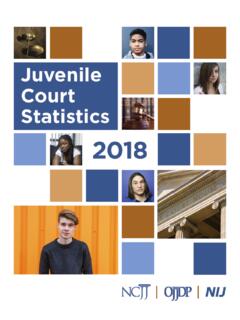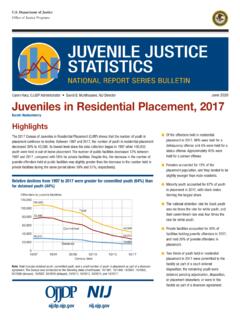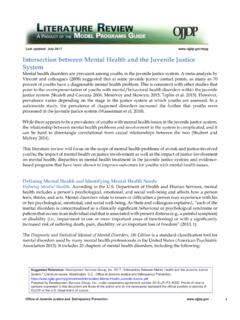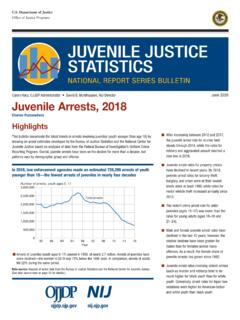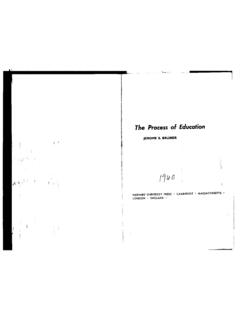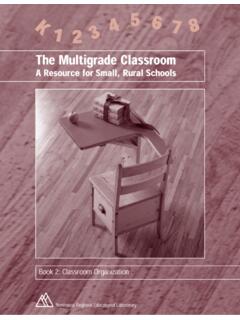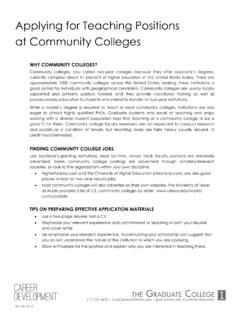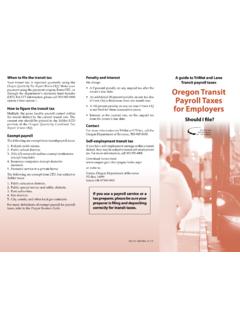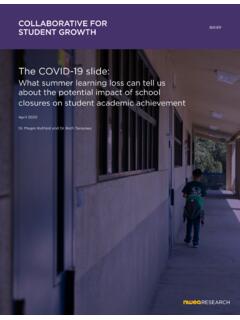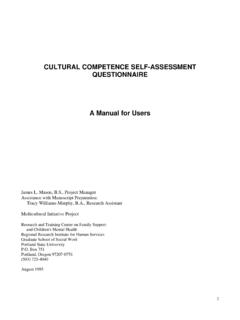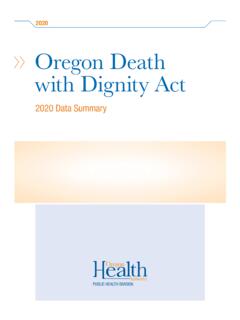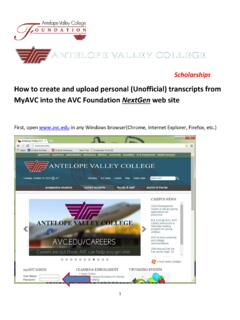Transcription of School Policies and Legal Issues Supporting Safe Schools
1 Effective Strategies for Creating Safer Schools and CommunitiesSchool Policiesand Legal Issues Supporting Safe SchoolsThis publication contains pages that have been left intentionally blank for proper pagination when Hutton and Kirk BaileyRevised September 2007 Published by: The Hamilton Fish Institute on School and Community Violence &Northwest Regional Educational LaboratoryWith support from:Office of Juvenile Justice and Delinquency Department of JusticeSafer Schools and Communitiesand Legal IssuesSupporting Safe SchoolsEffective Strategies for Creating School Policies Supporting Safe Schools School Policiesand Legal IssuesHamilton Fish Institute on School and Community ViolenceThe George Washington University2121 K Street NW, Suite 200, Washington, DC 20037-1830 Phone: (202) 496-2200E-mail: Fish Institute Director: Dr.
2 Beverly Caffee GlennCenter for Classroom Teaching and LearningNorthwest Regional Educational Laboratory101 SW Main St., Suite 500, Portland, OR 97204 Toll-free number: 1-800-547-6339, ext. 135E-mail: for Classroom Teaching and Learning Director: Kit PeixottoAuthors: Thomas Hutton and Kirk BaileyEditors:Ira Pollack, Michael GarringerTechnical editor: Eugenia Cooper PotterLayout design:Dennis WakelandCover design:Paula Surmann, Michael Heavener 2008, Hamilton Fish Institute on School and Community Violence and Northwest Regional Educational LaboratoryAll Rights ReservedThis project was supported by the Hamilton Fish Institute on School and Community Violence through Award No. 2005-JL-FX-0157 awarded by the Office of Juvenile Justice and Delinquency Prevention, Office of Justice Programs, Department of Justice.
3 Points of view or opinions in this document are those of the author and do not necessarily represent the official position or Policies of the Department of Justice or the Hamilton Fish the Effective Strategies for Creating Safer Schools and Communities SeriesSchool safety requires a broad-based effort by the entire community, including educators, students, parents, law enforcement agencies, busi-nesses, and faith-based organizations, among others. By adopting a com-prehensive approach to addressing School safety focusing on prevention, intervention, and response, Schools can increase the safety and security of assist Schools in their safety efforts, the Hamilton Fish Institute on School and Community Violence and the Northwest Regional Educational Laboratory (NWREL) have revised this series of five guidebooks intended to build a foundation of information that will assist Schools and School districts in developing safe learning environments.
4 The series identifies several components that, when effectively addressed, provide Schools with the foundation and building blocks needed to create and maintain safe Schools . Written in collaboration with leading national experts, these resources will provide local School districts with information and resources that support comprehensive safe School planning guide provides administrators and classroom practitioners with a glimpse of how fellow educators are addressing Issues , overcoming obstacles, and attaining success in key areas of School safety. They will assist educators in obtaining current, reliable, and useful information on topics that should be considered as they develop safe School strategies and positive learning environments. As emphasized in Threat Assessment in Schools : A Guide to Managing Threatening Situations and to Creating Safe School Climates, a joint publication of the Secret Service and the Department of Education, creating cultures and climates of safety is essential to the prevention of violence in School .
5 Each guidebook retains this message as a fundamental No Child Left Behind, the education law signed in January 2002, violence prevention programs must meet specified principles of effective-ness and be grounded in scientifically based research that provides evi-dence that the program to be used will reduce violence and illegal drug use. Building on the concept in No Child Left Behind that all children need a safe environment in which to learn and achieve these guides explain the importance of selecting research-based programs and strate-gies. The guides also outline a sample of methods for addressing and solv-ing safety Issues Schools may this series (continued)Creating Schoolwide Prevention and Intervention Strategies, by Jeffrey Sprague, is intended to put the issue of schoolwide violence prevention in context for educators and outline an approach for choosing and creating effective prevention programs.
6 The guide covers the following topics: Why schoolwide prevention strategies are critical Characteristics of a safe School Four sources of vulnerability to School violence How to plan for strategies that meet School safety needs Five effective response strategies Useful Web and print resourcesSchool Policies and Legal Issues Supporting Safe Schools , by Thomas Hutton and Kirk Bailey, is a practical guide to the development and implementation of School district and School Policies that support safe Schools . Section 1 provides an overview of Legal and practical considerations to keep in mind and to address with local Legal counsel when developing Policies at the district level to prevent violence. Section 2 addresses specific situations and Issues that may arise and discusses how the framework set forth in Section 1 bears on these Quality School Facilities and Security Technologies, by Tod Schneider, is intended to help educators and other members of the com-munity understand the relationship between School safety and School facilities, including technology.
7 The guide covers the following topics: Crime Prevention Through Environmental Design (CPTED) Planning To Address CPTED: Key Questions To Ask Security Technology: An Overview Safety Audits and Security SurveysThe Role of Mental Health Services in Promoting Safe and Secure Schools , by Krista Kutash and Albert Duchnowski, explores the role of mental health services in developing and maintaining safe Schools . The guide provides an overview of research-based School mental health models and offers guidance for School personnel and others on implementing mental health related services, including the role that federal, state, and district Policies play and the need for community involvement. vFostering School , Family, and Community Involvement, by Howard Adelman and Linda Taylor, provides an overview of the nature and scope of collaboration, explores barriers to effectively working together, and discusses the processes of establishing and sustaining the work.
8 It also reviews the state of the art of collaboration around the country, the importance of data, and some Issues related to sharing Hamilton Fish Institute on School and Community Violence and the Northwest Regional Educational Laboratory hope that the guides in this series assist your School and its partners in creating a safe, positive learn-ing environment for the children you this series (continued)viAbout the AuthorsThomas Hutton is a senior staff attorney with the National School Boards Association (NSBA), where his work includes amicus curiae advo-cacy in appellate court cases affecting public Schools and support to state School board associations, local School boards, and the NSBA Council of School Attorneys, the national professional association for attorneys who represent School districts.
9 A frequent writer and speaker on School law topics, he has represented School board positions in major media including C-SPAN s Washington Journal and National Public Radio s Talk of the Nation. He serves as editor of NSBA s free weekly Legal Clips e-newsletter and co-editor of Leadership Insider, the School law and policy newsletter for NSBA-affiliated School districts. He is a co-founder and former chair of the board of trustees of Thurgood Marshall Academy, a charter high School in the District of Columbia that has a thematic focus on law and democracy. He currently serves on the board of directors of the 21st Century School Fund, a nonprofit organization that focuses on Issues related to School facilities. Mr. Hutton was educated in public Schools in New Hampshire, Wisconsin, and Colorado and is a graduate of Connecticut College and the Georgetown University Law Center.
10 Kirk Bailey serves as Legislative Counsel at Smith Dawson & Andrews, providing expertise in education, transportation, justice and natural resources Issues , and constitutional and regulatory law. His background is in public affairs, lobbying and community outreach. He has served as special counsel to the Hamilton Fish Institute on School and Community Violence, where he advised the Institute on Legal Issues involving School safety, youth violence, student constitutional rights, and federal administrative Bailey is a graduate of the University of oregon , and holds a from the University Of oregon School Of Law, and is an active member of the oregon and American Bar ..1 Section 1. Legal and Practical Considerations Related to School Safety ..5 Due processNondiscriminationDisciplining students with disabilitiesSearch and seizureFreedom of expressionDisciplining students for off-campus conductFederal statutes on School safetyLiability for failure to prevent violencePrivacy considerationsSchool security personnel and law enforcementGeneral and practical considerationsSection 2.

